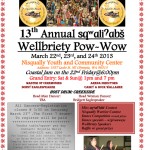
By Jack McNeel, Indian Country Today Media Network
The Colville Confederated Tribes’ successful effort to hold a British Columbia smelter accountable for dumping pollutants into the Columbia River for a century has caught the attention of the Sierra Club Washington State’s Upper Columbia River Group, which bestowed its 2013 Watershed Hero Award on the tribes.
Colville won a major victory in 2012 when the company, known today as Teck Metals Ltd. (formerly Teck/Cominco), admitted in court to depositing millions of tons of toxic substances into the river, which flows into Lake Roose-velt. Pollutants included 250,000 tons of zinc and lead, as well as 132,000 tons of other hazardous substances such as more than 200 tons of mercury, cadmium and arsenic.
The tribes, having pressed their case for two decades, also made legal history when the court struck down the notion that a foreign company could not be held liable under U.S. law. The victory was marked in high style on February 23 when Sierra Club leaders, including John Osburn, co-chair for Sierra Club’s Upper Columbia River group, joined tribal members in Spokane, Washington, for the presentation of its Water-shed Heroes honor at an awards dinner.
“Watershed Heroes are people who act out of love and respect for nature,” said Mary Verner, former director of Upper Columbia United Tribes and the former mayor of Spokane, who won the award last year and presented it this year.
“We’re very grateful for all the sacrifices you have made,” Verner said in introducing Colville Tribes chairman John Sirois and recognizing others from the tribes who had played major roles in the process.
“I’m grateful you relayed the history,” Sirois said. “I’m grateful for you honoring all the work of the past councils that really put in the time and effort. We have such a great legal team. There are countless people who played a role in this. It’s really a validation of who we are as a people. All along the river, those places are named after our people and where we come from: Okanogan, Chelan, Methow, Eniat, San Poil, Lakes, that is who we are. That is where our people are buried. That is where we’re born.”
Between 1896 and 1995, Teck’s smelter dumped 400 tons of waste a day—derived from the smelting process—into the Columbia River. The smelter is about 10 miles north of the U.S. border.
“It comes as no surprise that after being dumped into the Columbia River, all this toxic material flows downstream. The company tried to deny that,” Verner said. “Some of the most ridiculous arguments one has ever heard from a corporate entity have been raised by Teck/Cominco, now known as Teck Metals Ltd. The Colvilles weren’t having it.”
In the 1990s the tribes asked Canada to tell Teck to stop polluting the river, but Teck did not comply. The U.S. made similar attempts to stop the company but met with the same lack of results. In 2003 the U.S. Environmental Protection Agency identified Lake Roosevelt as a Superfund site and entered into an agreement with Teck to study the problem, making it clear that Teck would not be held responsible for the cleanup. But Teck found that unacceptable.
“In 2004 the tribes decided they could not wait any longer, and they filed a suit,” Verner said. Washington State eventually joined the tribes.
“To say the case of Pakootas v. Teck/Cominco is a landmark case would certainly be an understatement,” Verner said. “What a complex case it was! It has required navigating some incredible intricacies of the law, not even counting the science and politics.”
The tribes also got the court to overrule Teck’s argument that a company in another country cannot deliberately pollute U.S. waters and is not covered by U.S. law.
“The question is not where the polluter is located, but where the pollution is located,” Verner said. “It makes absolute sense, but the Colvilles had to fight for that outcome.”
Last April the court ruled that Teck could not escape liability. In September, Teck admitted it had knowingly and deliberately discharged 10 million tons of slag and toxic pollution into the Columbia. And in late 2012 a federal judge ruled that Teck qualifies as a polluter under the Superfund law.
“Heroes are tenacious,” Verner said of the tribes. “But it’s not over. Teck has appealed the ruling. They are trying to take this to the U.S. Supreme Court.”
As long as the bulk of the pollutants remain in the river or wash up on black beaches, the Colville Tribes will continue the battle. “Our future is about the water, all of us,” said Sirois. “We’re all in this fight together, to protect our environment, to protect our resources.”
Read more at http://indiancountrytodaymedianetwork.com/2013/03/06/watershed-heroes-colville-confederated-tribes-win-sierra-club-award-battling-british











